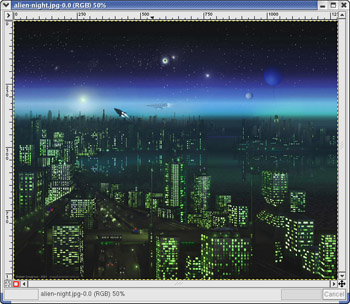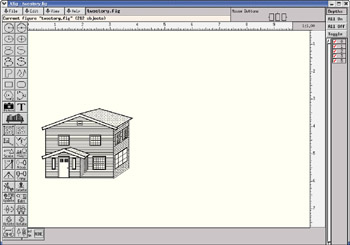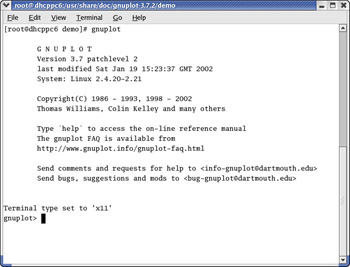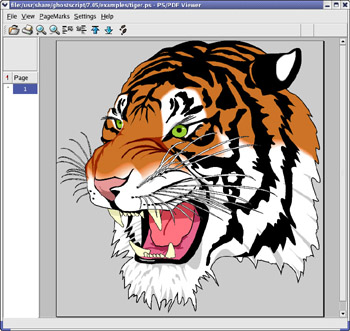Graphics and Images
Graphics and Images
The applications in this category enable you to work with images, graphics (line drawings and shapes), and sound. Chapter 5 describes the CD players you can use to play audio CDs on your Red Hat Linux system. The following applications, summarized in this chapter, enable you to prepare, view, modify, and print graphics and images:
-
The GIMP (the GNU Image Manipulation Program)—A program for viewing and performing image-manipulation tasks, such as photo retouching, image composition, and image creation
-
Xfig—A drawing program capable of producing engineering drawings
-
Gnuplot—A plotting package
-
Ghostscript—A PostScript interpreter capable of producing output on many devices, including output in various image-file formats
-
KGhostview—A KDE application capable of displaying PostScript and PDF files
Manipulating Images with the GIMP
The GIMP (GNU Image Manipulation Program) is an image-manipulation program written by Peter Mattis and Spencer Kimball and released under the GNU General Public License (GPL). It is installed if you select the Graphics Manipulation package when you install Red Hat Linux from this book’s companion CD-ROMs. The GIMP is comparable to other image-manipulation programs, such as Adobe Photoshop and Corel Photopaint.
To try out the GIMP, select Main Menu>Graphics>The GIMP from the GNOME desktop or the KDE desktop. The GIMP starts and displays a window with copyright and license information. Click the Continue button to proceed with the installation. The next screen shows the directories to be created when you proceed with a personal installation of the GIMP.
GIMP installation involves creating a directory called .gimp-1.2 in your home directory and placing a number of files in that directory. This directory essentially holds information about any changes to user preferences you might make to the GIMP. Go ahead and click the Continue button at the bottom of the window. The GIMP creates the necessary directories and copies the necessary files to those directories, then it displays an installation log.
After reading the installation log and ensuring that there are no error messages, click the Continue button. The GIMP then guides you through several screens from which you are asked to specify the values of some parameters; you can accept the defaults and click the Continue button in each screen until the installation window closes. From this time on, you won’t see the installation window; you have to deal with installation only when you run the GIMP for the first time.
The GIMP then loads any plug-ins—external modules that enhance its functionality. It displays a startup window that shows a message about each plug-in as it has loaded. After finishing the startup, the GIMP displays a tip of the day in a window and a number of windows, as shown in Figure 10-9. You can browse the tips and click the Close button to close the tip window.

Figure 10-9: The Initial Windows Displayed by the GIMP.
The initial GIMP windows include a main toolbox window titled The GIMP, a Tool Options window, a Brush Selection window, and a Layers, Channels & Paths window. Of these, the main toolbox window is the most important—in fact, you can close the other windows and work by using the menus and buttons in the toolbox.
The toolbox has three menus on the menu bar: File, Xtns (extensions), and Help. The File menu has options to create a new image, open an existing image, save and print an image, mail an image, and quit the GIMP. The Xtns menu gives you access to numerous extensions to the GIMP. The exact content of the Xtns menu depends on which extensions are installed on your system. The Help menu enables you to view tips and get help on the GIMP. For example, select Help>Help to bring up the GIMP Help Browser with online information about the GIMP.
To open an image file in the GIMP, select File>Open. This brings up the Load Image dialog box from which you can select an image file. You can change directories and select the image file you want to open. GIMP can read all common image-file formats, such as GIF, JPEG, TIFF, PCX, BMP, PNG, and PostScript. After you select the file and click the OK button, the GIMP loads the image into a new window. Figure 10-10 shows a JPEG image from the file /usr/share/wallpapers/alien-night.jpg, which the GIMP has opened.

Figure 10-10: Opening an Image with the GIMP.
Drawing Figures with xfig
The xfig program is an interactive drawing program that runs under X and can generate encapsulated PostScript files suitable for inclusion in documents. To use xfig, you need to install two RPM files—first the transfig RPM and then the xfig RPM.
To install xfig, follow these steps:
-
Mount each CD-ROM and search for the transfig and xfig RPMs. Insert each CD-ROM and wait for it to be mounted (or type mount /dev/cdrom to mount the CD-ROM). Then, type the following commands in a terminal window and look for the files:
cd /mnt/cdrom/RedHat/RPMS ls transfig* ls xfig*
-
After you find the files, install the transfig program with the rpm command as follows:
rpm -ivh transfig*.rpm
-
Install the xfig program with the rpm command as follows:
rpm -ivh xfig*.rpm
To try xfig, type xfig & in a terminal window. This command causes a rather large xfig window to appear. At the top edge of the window, you’ll find a menu bar. To open an xfig drawing, click the File button. That action brings up a file-selection dialog box, through which you can change directories and locate xfig files (they usually have the .fig extension).
You will find a large number of xfig drawings, organized into subdirectories, in the /usr/lib/X11/xfig/Libraries directory of your Red Hat Linux system (these files are installed when you install xfig). You can open and view some of these drawing files in xfig. For example, Figure 10-11 shows the xfig window after loading the drawing file /usr/lib/X11/xfig/Libraries/Buildings/twostory.fig.

Figure 10-11: A Sample Drawing That xfig Displays.
As is true of any other tool, learning to use all of the features of xfig takes some practice. If you are familiar with other drawing software, such as MacDraw (Macintosh) or CorelDRAW (PC), you should be able to use xfig without much trouble.
Plotting Data with Gnuplot
Gnuplot is an interactive plotting utility. You need to run Gnuplot under the X Window System because it uses an X window as the output device. Gnuplot is command-line-driven program; it prompts you and accepts your input commands. In response to those commands, Gnuplot displays various types of plots. The output appears in an X window.
To install Gnuplot, follow these steps:
-
Mount each CD-ROM and search for the gnuplot RPM. Insert each CD-ROM and wait for it to be mounted (or type mount /dev/cdrom to mount the CD-ROM). Then, type the following commands in a terminal window and look for the file:
cd /mnt/cdrom/RedHat/RPMS ls gnuplot*
-
After you find the file, install Gnuplot with the following rpm command:
rpm -ivh gnuplot*.rpm
At any time in Gnuplot, you can ask for online help. The help is similar to that in the old DEC VAX/VMS system. To learn more about the plot command, for example, type help plot at the Gnuplot prompt.
Gnuplot also comes with several example files that appear in the /usr/lib/gnuplot/ demos directory of your system. To try these demo files, type the following commands in a terminal window:
cd /usr/share/doc/gnuplot* cd demo gnuplot
When the Gnuplot prompt appears, load one of the demo files (the ones with the .dem extension) with the load command. To load the world.dem file, for example, type the following command at the Gnuplot prompt:
load "world.dem"
The world.dem Gnuplot file displays a map of the world and pauses until you press Enter. After you press Enter, Gnuplot displays the next plot, which happens to be a view of the earth in spherical coordinates, as shown in Figure 10-14.

Figure 10-14: A 3D Plot of the World in Gnuplot.
If you are curious about the world.dem file, here’s what it contains:
# # $Id: world.dem,v 1.1.1.1.2.3 2001/12/04 14:12:53 lhecking Exp $ # # set title "Gnuplot Correspondences" set nokey set noborder set noyzeroaxis set noxtics set noytics # # Plot world map and correspondent locations as a + plot 'world.dat' with lines 3 4, 'world.cor' with points 1 2 set title "" set key set border set yzeroaxis set xtics set ytics pause -1 "Hit return to continue." # # plot a '3D version using spherical coordinate system' of the world. set angles degrees set title "3D version using spherical coordinate system" set ticslevel 0 set view 70,40,0.8,1.2 set mapping spherical set parametric set samples 32 set isosamples 9 set urange [-90:90] set vrange [0:360] splot cos(u)*cos(v),cos(u)*sin(v),sin(u) with lines 5 6,\ 'world.dat' with lines 3 4, 'world.cor' with points 1 2 pause -1 "Hit return to continue" # # Plot a '3D version using cylindrical coordinate system' of the world. set title "3D version using cylindrical coordinate system" set ticslevel 0.0 set view 70,40,0.8,1.2 set mapping cylindrical set parametric set samples 32 set isosamples 9 set urange [-180:180] set vrange [-90:90] splot cos(u),sin(u),v with lines 5 6,\ 'world.dat' with lines 3 4, 'world.cor' with points 1 2 pause -1 "Hit return to continue." reset
As the listing shows, the world.dem file consists of Gnuplot commands. You can learn a great deal about Gnuplot by trying each file in the Gnuplot demo directory and by studying the commands in the file.
Working with PostScript in Ghostscript
Ghostscript is a utility for previewing and printing PostScript documents. Ghostscript enables you to print PostScript documents on many non-PostScript devices.
At its heart, Ghostscript is a nearly complete implementation of the PostScript language. Ghostscript includes the interpreter that processes PostScript input and generates output on an output device. A Ghostscript device can be a printer (or display screen), as well as an image-file format, such as BMP or PCX.
Ghostscript is distributed under the GNU GPL but is copyrighted and maintained by Aladdin Enterprises. The latest version remains under Aladdin’s control for one year after its release, at which point it is transferred to the Free Software Foundation and can be distributed under GPL.
Ghostscript takes several command-line arguments, including the file to be loaded. To see a list of Ghostscript options, type the gs -h command.
To see how Ghostscript renders a PostScript document, you can use any PostScript document you have available. You can view one of the sample PostScript files in the /usr/share/ghostscript/7.05/examples directory (replace 7.05 with whatever version of Ghostscript is installed on your system). Type the following command, for example, in a terminal window:
gs /usr/share/ghostscript/7.05/examples/golfer.ps
Ghostscript opens that file, processes its contents, and displays the output in another window, as shown in Figure 10-15.

Figure 10-15: Ghostscript Displaying a PostScript File.
In this case, the output happens to be a picture of a golfer. After displaying the output, Ghostscript displays the following message:
>>showpage, press <return> to continue<<
Press Enter to continue. For a multiple-page PostScript document, Ghostscript then shows the next page. After all the pages are displayed, you return to the Ghostscript prompt. Type quit to exit Ghostscript.
Viewing PostScript or PDF Files with KGhostview
KGhostview is a KDE application that’s essentially a graphical front end to the Ghostscript interpreter. KGhostview is ideal for viewing and printing PostScript and PDF documents. For a long document, you can view and print selected pages. You can also view the document at various levels of magnification by zooming in or out.










